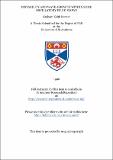Files in this item
Instability and wave-growth within some oscillatory fluid flows
Item metadata
| dc.contributor.advisor | Craik, Alex D. D. | |
| dc.contributor.author | Forster, Graham Keith | |
| dc.coverage.spatial | 200 p. | en_US |
| dc.date.accessioned | 2018-06-14T15:25:13Z | |
| dc.date.available | 2018-06-14T15:25:13Z | |
| dc.date.issued | 1996 | |
| dc.identifier.uri | https://hdl.handle.net/10023/14087 | |
| dc.description.abstract | Oscillatory fluid flows arise naturally in many systems. Whether or not these systems are stable is an important question and external periodic forcing of the flow may result in rich and complicated behaviours. Here three distinct oscillatory fluid flows are examined in detail, with the stability of each being established using a range of analytical and computational methods. The first system comprises standing surface capillary-gravity waves in second-harmonic resonance subject to Faraday excitation. Using the perturbation technique of multiple scales, the amplitude equations for the system are derived. At exact resonance, and with the absence of damping, the only fixed point of the equations is found to be the origin. A computational approach reveals that the amplitudes of the two waves remain either bounded or grow to infinity depending on initial data. With the introduction of detuning and damping into the system families of fixed points now exist and some special cases are considered. The second class of flows are unbounded time-periodic flows with fixed ellipsoidal stream surfaces, and having spatially uniform but time-periodic strain rates. Using a recently developed method based on theoretical study of the Schrodinger equation with quasi-periodic potential, a computational approach is adopted which determines the stability of the flow to three-dimensional plane wave disturbances. Results for the growth rate and winding number of the disturbance clearly reveal the regions of instability. It is found that almost all these flows are highly unstable. The third class is another set of three-dimensional time-periodic flows with spatially uniform strain rates. These flows are non-axisymmetric and have sinusoidally-fluctuating rates of strain directed along the fixed coordinate axes. The same computational method is employed and it is found that instability increases along with the non-axisymmetric nature of the flow. | en_US |
| dc.language.iso | en | en_US |
| dc.publisher | University of St Andrews | en |
| dc.subject.lcc | QA927.F7 | |
| dc.subject.lcsh | Wave-motion, Theory of. | en |
| dc.title | Instability and wave-growth within some oscillatory fluid flows | en_US |
| dc.type | Thesis | en_US |
| dc.type.qualificationlevel | Doctoral | en_US |
| dc.type.qualificationname | PhD Doctor of Philosophy | en_US |
| dc.publisher.institution | The University of St Andrews | en_US |
This item appears in the following Collection(s)
Items in the St Andrews Research Repository are protected by copyright, with all rights reserved, unless otherwise indicated.

